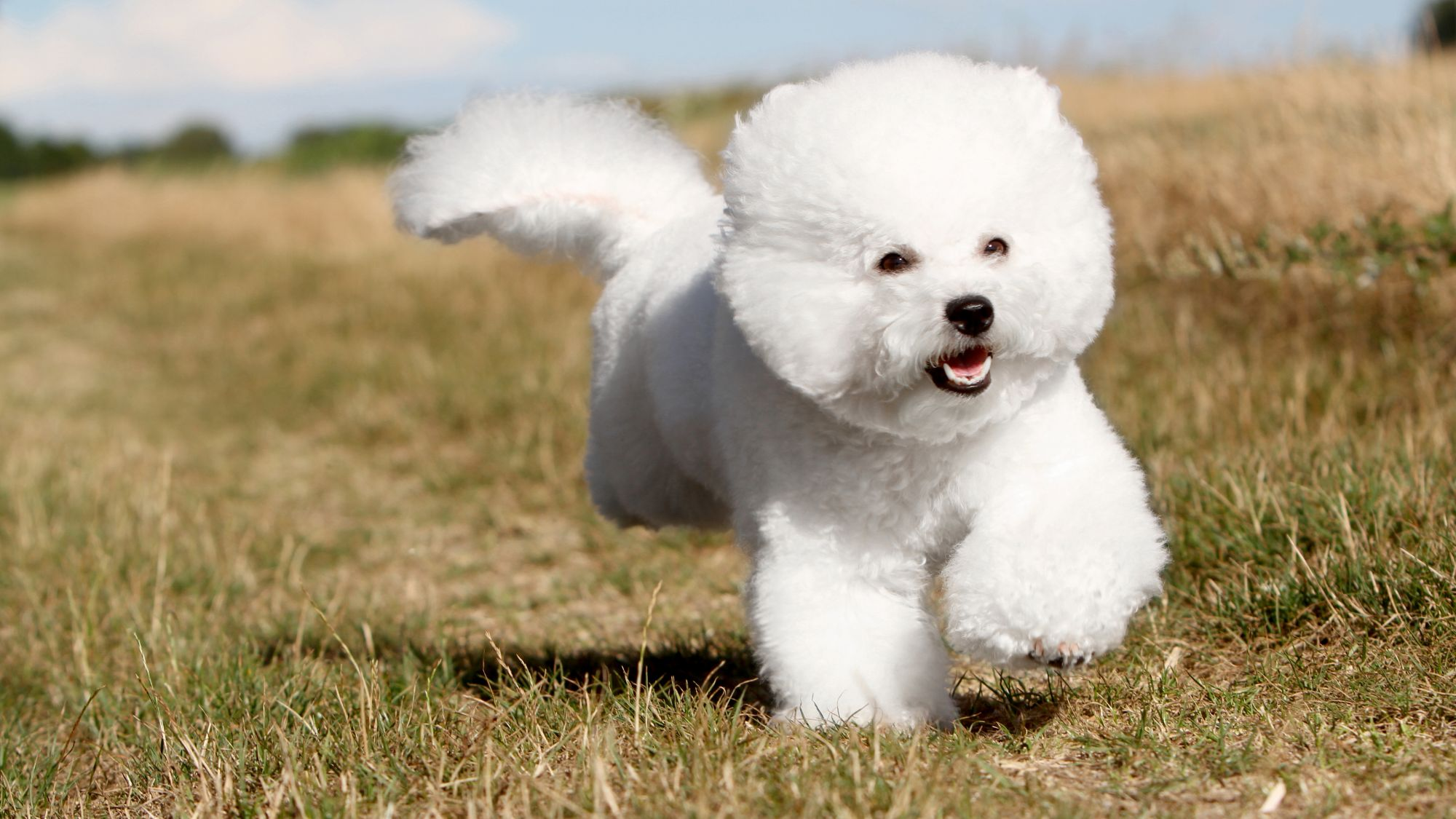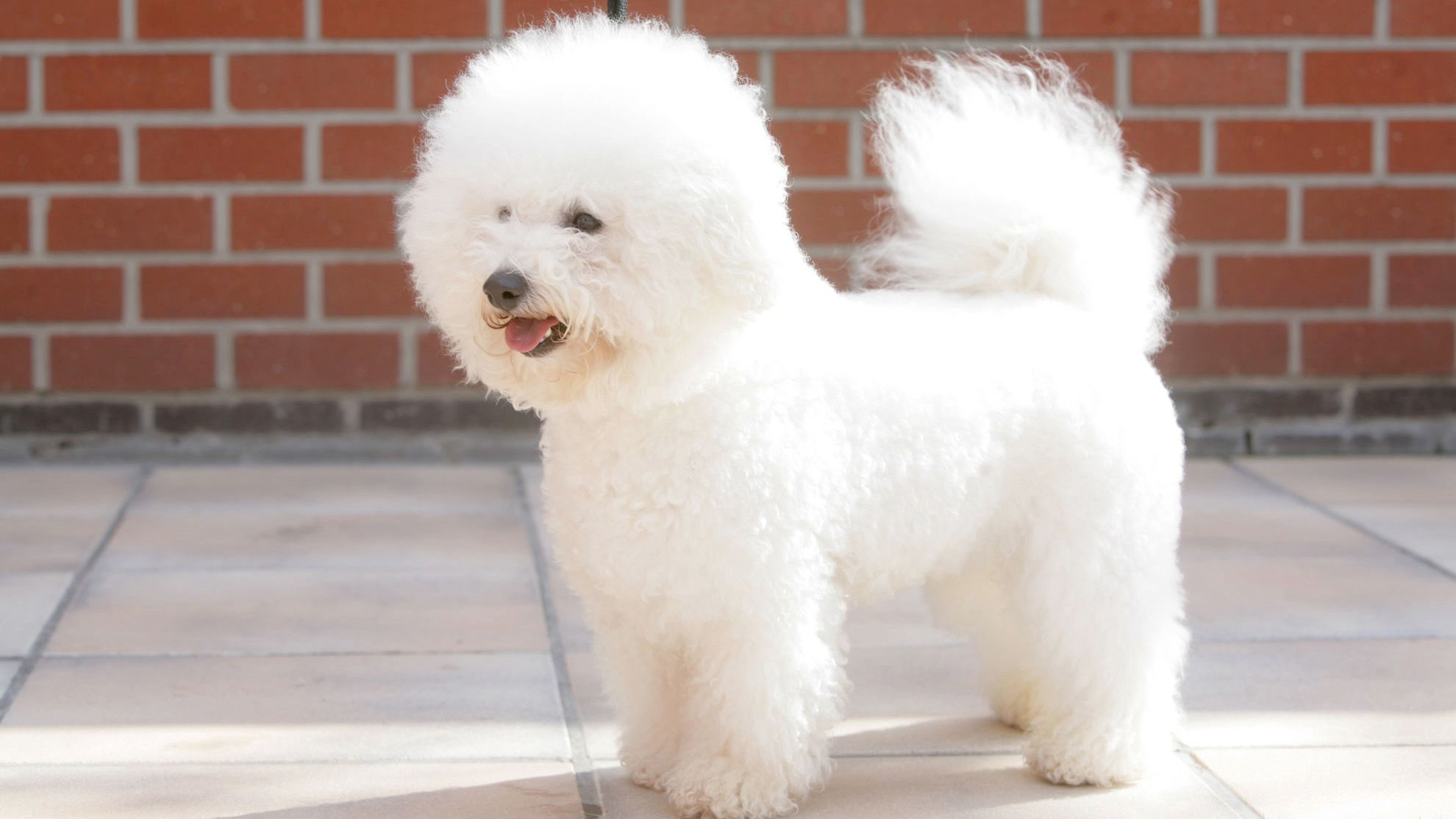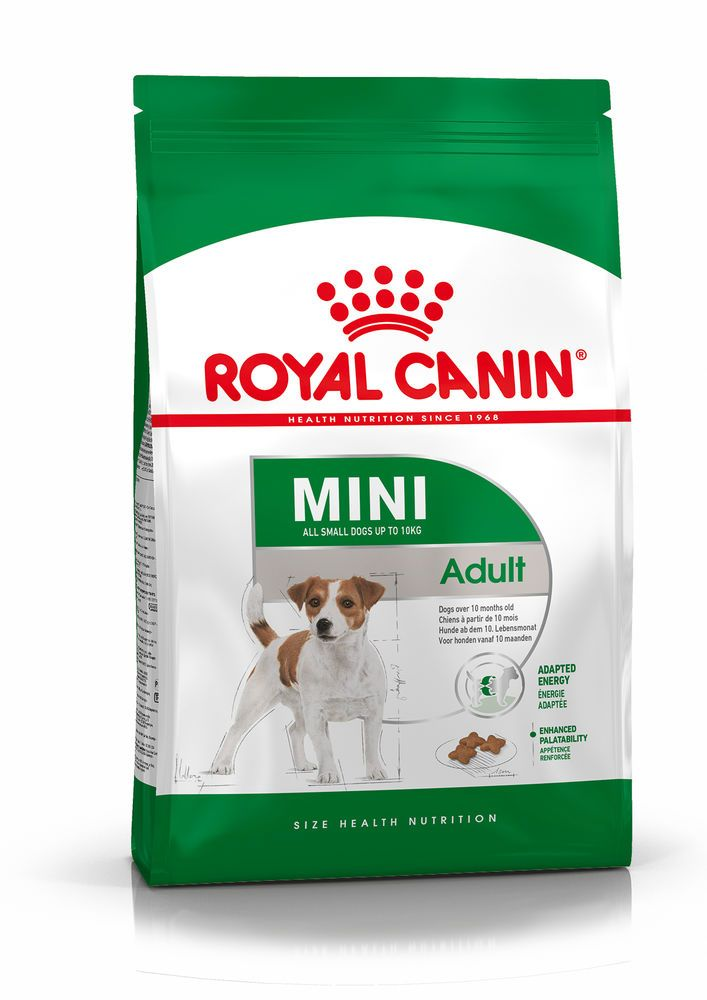Parlons du bichon frisé
Il est difficile de décrire le bichon frisé sans employer le mot « pelucheux ». Leurs poils ressemblent à des nuages extrêmement doux. L'effet gonflé est toutefois facultatif (cette symétrie soignée n'est pas innée). Et bien qu'ils ne perdent pas leurs poils, les bichons frisés doivent absolument faire l'objet d'un toilettage quotidien pour éviter que leur magnifique pelage ne s'emmêle. Naturellement affectueux et très amical, le bichon frisé ne fait pas toujours la distinction entre les personnes qu'il connaît et celles qu'il ne connaît pas. Il accueille tout le monde avec un enthousiasme débordant. C'est un vrai bonheur que d'avoir affaire au tempérament du bichon frisé qui se caractérise comme une race joueuse.
Nom officiel : bichon frisé
Autres noms : bichon à poil frisé
Origines : France
Tendance à baver
1 out of 5Perte de poils
1 out of 5Niveau d’énergie*
3 out of 5Cohabitation avec d'autres animaux
5 out of 5Apprécie les températures élevées ?
3 out of 5Adapté à la vie en appartement
4 out of 5Animal de compagnie*
5 out of 5
| Mâle | Femelle |
|---|---|
| Taille | Taille |
| 25 - 30 cm | 23 - 28 cm |
| Poids | Poids |
| 5 - 8 kg | 5 - 8 kg |
| Les étapes de la vie | |
|---|---|
| Âge adulte | |
| De 10 mois à 8 ans | |
| Âge mature | Âge avancé |
| De 8 à 12 ans | À partir de 12 ans |
| Jeune chiot | |
| De la naissance à 2 mois | |

Découvrez le bichon frisé
Tout savoir sur cette race
Bichon frisé ou bichon à poil frisé ? Si le monde entier s'accorde sur le fait qu'il s'agisse d'une race joueuse, ouverte et sociable, son nom fait davantage débat et peut prendre de multiples formes et se prononcer différemment selon les langues. En français, on parle de bichon à poil frisé, ou de bichon frisé, en accentuant la dernière lettre. Dans les pays anglophones, la race est connue sous le nom de bichon frise, qui s'écrit et se prononce sans accent aigu. Ces différences ont bien peu d'importance étant donné que ces chiens confiants ont une forte identité.
Facile à vivre et plein d'énergie, ce chien s'adapte parfaitement à la vie urbaine en raison de sa petite taille et de sa nature décontractée. Comme dit précédemment, le bichon frisé ne considère personne comme un étranger, et n'attend des inconnus que de les rencontrer. Ils sont connus pour forger des liens incroyablement forts avec les personnes qui les entourent. Ils suivront leur propriétaire.
Également connu pour son pelage soyeux et pelucheux, le bichon frisé doit être brossé presque au quotidien pour garder toute sa splendeur. Il est très probable qu'il passe beaucoup de temps sur vos genoux, alors gardez simplement une brosse à proximité.
Les bichons frisés se distinguent par des nuances de blanc différentes, et peuvent arborer un pelage d'une extrême blancheur ou aller jusqu'à présenter un poil blanc qui tire légèrement sur l'abricot. Si vous pensez que le bichon ressemble fortement à un bichon maltais, à un bichon havanais ou à un bichon bolonais, alors sachez que vous avez un bon œil. Ces races ne sont pas si éloignées.
Si l'apprentissage de la propreté du bichon frisé peut prendre un peu plus de temps, son intelligence fait qu'il réagit bien à l'éducation positive basée sur les récompenses. Il veut avant tout vous satisfaire.

2 caractéristiques du bichon frisé
1. Parlez-vous Français ?
Vous pensez surement que le bichon frisé, a des origines françaises. Toutefois les premiers ancêtres de la race étaient en réalité espagnols et italiens, marins et nobles à parts égales. C'est pourquoi certains évoquent les origines méditerranéennes du bichon frisé, ce qui brouille un peu les pistes.
2. Être au point sur le toilettage
Il s'agit certes d'une race extrêmement facile à vivre, mais on ne peut pas en dire autant de son toilettage. Ce pelage doux et pelucheux doit être brossé quotidiennement si possible pour éviter qu'il ne s'emmêle. De plus, comme pour de nombreuses races de petite taille, ces chiens peuvent être sujets aux problèmes de dents et de gencives. Munissez-vous également d'une brosse à dents ! La bonne nouvelle : le brossage ne prend pas beaucoup de temps.

Historique de la race
L'histoire du bichon frisé est longue, mais n'en reste pas moins intéressante. Typiquement et légitimement associée à la France, la race serait à l'origine descendue des chiens de navigation espagnols des îles Canaries, tenant compagnie aux marins lors des longs périples. Le bichon Tenerife, comme on l'appelait, est considéré comme l'un des ancêtres du bichon frisé.
Il a été introduit, au XIIIe siècle, dans les cours royales de toute l'Espagne, d'Italie et de France. C'est en France que ce chien gracieux que nous connaissons et chérissons aujourd'hui a été élevé, probablement à la Renaissance, au XVIe siècle. Adoré par la noblesse, le bichon frisé a connu un grand moment. Un basculement s'opère au début de la Révolution française. Alors que les propriétaires royaux étaient condamnés à la guillotine , le bichon frisé a été livré à lui-même. Sauvée sous le règne de Napoléon III, la race est réintroduite à la cour royale, adorée, choyée et pomponnée, à l'origine d'un nouveau verbe français : bichonner, qui signifie « choyer ».
Tout au long de l'histoire du bichon frisé, les cynophiles sont intervenus pour faire perdurer la race alors que la renommée du chien ne cessait tantôt de grandir ou de décliner. Ils ne sont apparus en Amérique qu’en 1955. Le Bichon Frise Club of America a été créé en 1964 (notez l'américanisation du nom) et la race a finalement été reconnue par l'American Kennel Club en 1971.
DE LA TÊTE À LA QUEUE
Caractéristiques physiques du bichon frisé
1.Cou
2.Yeux
3.Oreilles
4.Tête
5.Pelage

LES POINTS À SURVEILLER
Découvrez quelques points intéressants sur votre bichon frisé , qu'il s'agisse de caractéristiques spécifiques de la race ou d'un aperçu général sur sa santé
Une race en bonne santé dans l'ensemble
Dans l'ensemble, le bichon frisé est une race en bonne santé. Toutefois, un éleveur réputé aura examiné les parents pour détecter certains problèmes de santé. Vous devrez tester chaque année les problèmes de hanche et de rotule. La race peut également être sujette aux infections de la vessie ainsi qu'aux affections oculaires appelées « glaucome ». Il est toujours préférable de vérifier régulièrement les yeux de votre chien, et de vérifier qu'il ne plisse pas des yeux, ou qu'il ne présente pas de signes d'irritation aqueuse, ou de gonflement ou de renflement. Si vous remarquez quelque chose d’inhabituel, il est préférable de consulter votre vétérinaire dès que possible. Il vous aidera à maintenir votre chien en bonne santé.
N’oubliez pas la brosse à dents.
Comme de nombreuses races de chien toy, les bichons frisés peuvent être sujets à des problèmes de dents et de gencives. Ces problèmes peuvent se transformer en « maladie parodontale », qui se veut être une inflammation et infection du tissu gingival, s'ils ne sont pas traités. En plus d'être douloureux pour votre bichon frisé, ces problèmes peuvent également entraîner des difficultés à manger ainsi que la perte de dents, et des complications potentiellement plus graves. Il est donc préférable de prévenir cela par un brossage quotidien. Il est également recommandé de réaliser des contrôles et des examens chez votre vétérinaire.
Une alimentation saine pour un chien en meilleure santé

Lorsqu'il s'agit de choisir la nourriture d'un bichon frisé, de nombreux facteurs doivent être pris en compte : l'âge, le mode de vie, le niveau d'activité, l'état physiologique et la santé, y compris les maladies ou sensibilités potentielles. La nourriture apporte l’énergie nécessaire pour couvrir les fonctions vitales d’un chien. Par ailleurs, une formule nutritionnelle complète doit comporter un équilibre précis de nutriments pour éviter toute carence ou excès dans son alimentation, tous deux susceptibles de compromettre sa santé.
Les recommandations suivantes s'appliquent à des animaux en bonne santé. Si votre chien a des problèmes de santé, veuillez consulter votre vétérinaire qui vous prescrira un régime alimentaire exclusivement vétérinaire.
De l'eau propre et fraîche doit être à mise à la disposition de votre chien en permanence, afin de garantir sa santé urinaire. Emportez de l'eau lorsqu'il fait chaud et surtout lorsque votre chien se dépense, afin de lui en proposer fréquemment.
Les besoins d'un chiot bichon frisé en termes d'énergie, de protéines, de minéraux et de vitamines sont bien supérieurs à ceux d'un adulte. Ils ont besoin d'énergie et de nutriments pour entretenir leur corps, mais aussi pour le développer et le construire. Le système immunitaire d'un chiot bichon frisé se développe progressivement jusqu'à l'âge de 8 mois. Un complexe d'antioxydants, dont la vitamine E, peut aider à soutenir leurs défenses naturelles pendant cette période de grands changements, de découvertes et de nouvelles rencontres. Leurs fonctions digestives sont également différentes de celles d'un bichon frisé adulte : leur système digestif n'est pas encore mature, il est donc important de leur fournir des protéines hautement digestibles qui seront utilisées efficacement. Un apport équilibré en fibres, comme le psyllium, peut aider à faciliter le transit intestinal et favoriser la production de selles de qualité.
De même, les dents d'un chiot, qui sont initialement des dents de lait, ou premières dents, remplacées ensuite par les dents définitives, sont un facteur important qui doit être pris en compte lors du choix de la taille, de la forme et de la texture des croquettes. Cette phase de croissance implique également des besoins énergétiques élevés. L’aliment doit donc offrir une haute teneur énergétique (exprimée en Kcal/100 g d’aliment). Par ailleurs, les concentrations de tous les autres nutriments seront également plus élevées que la normale dans un aliment spécialement formulé pour la croissance. Il est recommandé de diviser la ration quotidienne en trois repas par jour jusqu'à l'âge de six mois, puis de passer à deux repas par jour.

Voici les principaux objectifs nutritionnels pour un bichon frisé adulte :
Maintenir un poids corporel idéal en utilisant des ingrédients hautement digestibles et en maintenant la teneur en matières grasses à un niveau raisonnable. Le bichon frisé est essentiellement un chien d'intérieur et est connu pour sa tendance à l'embonpoint. Pour maintenir un poids idéal et des articulations en bonne santé, l'alimentation de cette race doit être adaptée de manière à booster le tonus musculaire. Ces chiens doivent également faire des activités au quotidien. Les bichons frisés ne doivent pas être nourris avec de la nourriture humaine ou des friandises grasses. Suivez scrupuleusement les recommandations des quantités mentionnées sur l'emballage, afin de prévenir toute prise de poids excessive. En plus de vivre en intérieur, la stérilisation contribue également au surpoids chez les chiens.
Préserver la santé du système urinaire. Le bichon frisé est prédisposé aux calculs urinaires qui se forment dans la vessie ou les voies urinaires, en cause, un faible volume d'urine et un nombre insuffisant de mictions. Une teneur en minéraux optimale dans le cadre d'une alimentation équilibrée peut contribuer à limiter ce trouble.
Préserver la santé et la splendeur de leur peau et de leur pelage. Le bichon frisé est connu pour sa peau sensible. Ils ont donc besoin d'une alimentation spécifique qui leur offrira des nutriments comme des acides gras oméga 3 (EPA-DHA) et de la vitamine A. Leur pelage pousse constamment et nécessite d'être régulièrement toiletté.
Prévenir les problèmes dentaires. En réduisant la formation de tartre sur les dents, responsable de la formation de plaque dentaire, les croquettes jouent un rôle essentiel dans la lutte contre les troubles bucco-dentaires. Une formule contenant des chélateurs de calcium permettra de favoriser la santé dentaire en réduisant la formation de tartre. Les croquettes doivent être très petites et adaptées à la mâchoire miniature des bichons frisés afin que ceux-ci puissent facilement les assimiler. Cela peut également stimuler leur appétit difficile.

Après 8 ans, les bichons frisés commencent à présenter les premiers signes de vieillissement. Une alimentation enrichie en antioxydants permet de maintenir la vitalité, et des nutriments clés, tels que la taurine, favorisent la santé de la fonction cardiaque. Le vieillissement s'accompagne également d'une modification des capacités digestives et de besoins nutritionnels particuliers. Les aliments pour les bichons frisés âgés doivent donc présenter les caractéristiques suivantes :
Teneur plus élevée en vitamines C et E. Ces nutriments ont des propriétés antioxydantes, qui protègent les cellules de l'organisme des effets néfastes du stress oxydant lié au vieillissement.
Protéines de haute qualité. Contrairement à une idée fausse largement répandue, la réduction de la teneur en protéines dans les aliments ne permet pas de limiter efficacement l'insuffisance rénale car les chiens plus âgés n'assimilent pas les protéines alimentaires aussi bien que les chiens plus jeunes. Réduire la teneur en phosphore est l'unique moyen de ralentir la détérioration progressive de la fonction rénale.
Une proportion plus élevée d'oligo-éléments fer, zinc et manganèse pour préserver la santé de la peau et du pelage.
Une quantité plus élevée d'acides gras polyinsaturés (huile de bourrache ou huile de poisson) pour garantir la qualité du pelage. Les chiens produisent normalement ces acides gras, mais le vieillissement peut affecter ce processus physiologique.
Avec l'âge, les chiens souffrent de plus en plus de problèmes dentaires. Pour qu'ils continuent à manger en quantité suffisante, la forme, la taille et la dureté de leurs croquettes doivent être adaptées à leur mâchoire.

Prendre soin de votre bichon frisé
Conseils en matière de toilettage, d'éducation et d'exercice
7/7
Tout savoir à propos du bichon frisé
Même s'il ne faut pas faire de généralités au sein d'une race, les bichons frisés sont connus pour être affectueux et dévoués à leurs maîtres. Bien qu'ils apprécient les séances de jeu (avec vous c'est encore mieux !), vos genoux revêtiront un attrait tout particulier à leurs yeux, au moment de la sieste.
La plupart posent cette question en pensant que les bichons frisés sont hypoallergéniques car ils ne perdent pas leurs poils. En réalité, aucun chien n'est complètement exempts d'allergène. Cela dit, le bichon frisé figure régulièrement en tête de liste des chiens recommandés aux personnes allergiques, car leur mue est minime.
Races suggérées
En savoir plus à ce sujet
Sources
- Veterinary Centers of America https://vcahospitals.com/ ;
- Royal Canin Dog Encyclopaedia. Éditions 2010 et 2020
- Banfield Pet Hospital https://www.banfield.com/
- Catalogue produits Royal Canin BHN
- American Kennel Club https://www.akc.org/
Aimer et partager cette page